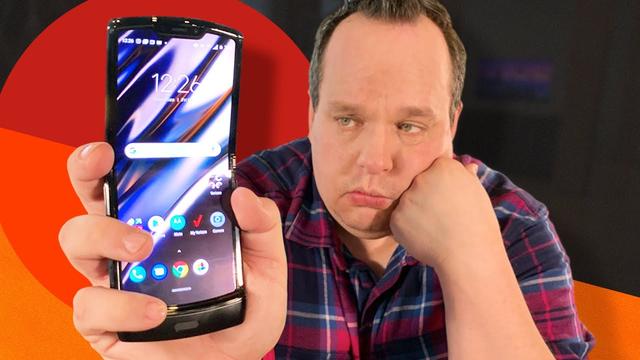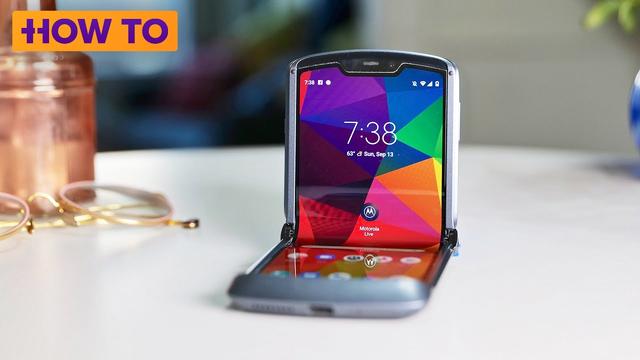
Does our Motorola Razr fold test mean this phone won't last a year? Not quite
When I first caught wind of a new Motorola Razr on the horizon, one of my initial reactions was, "We've got to put it in the FoldBot!" Spoiler alert: The Razr's fold test didn't come close to the 120,000 folds that we achieved with the Galaxy Fold last fall, or even to our goal of 100,000 folds, capping out at 27,000 before we had to pull the plug on the experiment. If the average American checks their phone 52 times a day, as CNET reported in 2018 (or even 96 times per day, according to a 2019 report from Asurion), do our test results mean the Razr foldable phone, released Feb. 6, will not last a year or two of regular use? Not quite.
First, some background on the FoldBot experiment: CNET began streaming what we hoped would be a 12-plus-hour live show to find out if the phone could hold up to being folded 100,000 times. Note that we used a Razr we purchased ourselves.
The goal was to stream the test until the wee hours of Friday morning when we planned to hit 100,000 folds. As soon as the test started, however, we noticed the FoldBot was having some trouble closing the phone all the way each time. During our 4 p.m. check-in, I noticed the hinge was very stiff and resistant to being closed all the way, almost as if something had come loose and was blocking it. After flexing the hinge a few times by hand, however, it started to loosen up some. It was definitely not functioning as intended, but still usable.
Read: CNET's in-depth review of the Motorola Razr
I tried putting the Razr back into the FoldBot one more time, but the machine was unable to overcome the stiffness of the hinge, and wouldn't fold the phone any more. So, with around 27,000 folds on the counter, we stopped the test and called it a day.
As of Friday morning, the Razr's hinge is still a little stiff, but it still opens and closes. One new thing I noticed upon closer inspection was that there are two new visible "creases" in the plastic screen. To my eye, they seem to correspond with the steel plates behind the screen that are part of the folding mechanism. They're subtle, but they're there.

Just like when we tested the Samsung Galaxy Fold, we borrowed the FoldBot machine from SquareTrade, a San Francisco-based company that offers warranties for consumer electronics and appliances. The FoldBot was originally created to open and close the Galaxy Fold repeatedly, thousands of times over.
SquareTrade modified the FoldBot to accommodate the new Razr, and it's been gracious enough to let us borrow it again, even before the company gets to test the Razr itself. As it turns out, the company may need to tweak its design a bit, but hopefully our test will provide good data for it.
Motorola Razr is a foldable flip phone like you've never seen before
See all photos+58 MoreSo, do the results of our test indicate that the $1,499 Razr won't last a full year of regular wear and tear? No. Besides our concerns about the FoldBot's design modifications to test the Razr (not to mention that the rapid open-and-close mechanism doesn't truly mimic real-world use), the stats on average daily phone checks were all thus far collected from nonfolding phones. Who's to say if foldable phone users might actually check their phones more frequently because of that satisfying click? (We certainly found that with the Huawei Mate X.) Or perhaps many foldable users' daily phone checks will not even involve an unfold-fold maneuver at all, as the Razr's 2.7-inch outer screen already displays the time, notifications and basics such as signal and battery life, as CNET's Jessica Dolcourt found in her hands-on preview of the Motorola Razr. You'll be able to use the outer screen to respond to texts through canned messages or your voice, without ever unfolding it, she found.
Following our test, we received the following statement from Motorola:
[The] razr is a unique smartphone, featuring a dynamic clamshell folding system unlike any device on the market. SquareTrade's FoldBot is simply not designed to test our device. Therefore, any tests run utilizing this machine will put undue stress on the hinge and not allow the phone to open and close as intended, making the test inaccurate. The important thing to remember is that razr underwent extensive cycle endurance testing during product development, and CNET's test is not indicative of what consumers will experience when using razr in the real-world. We have every confidence in the durability of razr.
And honestly, I have confidence in the Razr too. Being a former owner of the original Razr (mine was hot pink), I was definitely looking forward to trying out the new one in person. And now that I have, I'm pretty impressed with the design and the functionality. Did it survive 100,000 folds? No. Does it feel like a durable, resilient phone that will stand up to extended real-world use? To me it does.
You can head over to YouTube to see the full Razr folding test.
Now playing:Watch this: Motorola Razr foldable phone: We go in-depth on the hinge5:45Originally published Feb. 6.
Update, Feb. 7: Adds the results of the FoldBot test.
}})